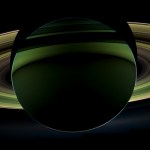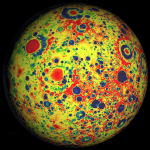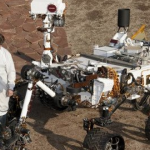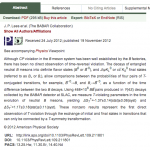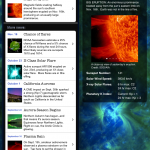Cosmos
Never mind Fresh Water Diatoms hitching a ride on meteors. We've got a possible Gamma Ray Burst in about 774 or 775 CE to talk about. Phil Plait has described the phenomenon which is reported here.
The tl;dr: Extra 14C Beryllium in tree rings laid down at that time had to come from somewhere, and the best explanation at present is a gamma ray burst resulting from two neutron stars melding. This might have been visible; some say that a visible signature would have been in the sky for a while, but maybe not. The gamma ray burst itself would be one of those colorless odorless tasteless…
From NASA:
On Oct. 17, 2012, during its 174th orbit around the gas giant, Cassini was deliberately positioned within Saturn's shadow, a perfect location from which to look in the direction of the sun and take a backlit view of the rings and the dark side of the planet. Looking back towards the sun is a geometry referred to by planetary scientists as "high solar phase;" near the center of your target's shadow is the highest phase possible. This is a very scientifically advantageous and coveted viewing position, as it can reveal details about both the rings and atmosphere that cannot be seen in…
Ebb and Flow were the twin space craft that mapped in the Moon's gravitational field by flying near each other, and then as the gravity of the Moon tugged on them they could suss out how much gravity that was, exactly. The gravity map of the moon, actually two of them, at two different scales, is done, so the space craft were "de-orbited."
To me, the first thing that is really interesting about this is the fact that they kept the space craft in very very low orbit for a long time. We earthlings tend to think of orbiting as something you have to do at high altitude, because we always send…
Fifty years ago to day a space ship passed by the planet Venus. The Earthlings had named the space craft "Mariner 2" and sent it to Venus for purely scientific purposes. Interplanetary domination was never the intention of this or any other Earth mission.
And that began the story of planetary exploration as we know it.
I believe Mariner 2 was the 13th exploratory un-personed space mission by NASA.
Ebb and Flow, the Twin Gravity Recovery and Interior Laboratory (GRAIL) Space Ships, which have been employed to provide detailed gravitational mapping of the Moon's geology, have apparently served their purpose and will be reprogrammed in a few hours from now to crash into the moon on Monday.
PASADENA, Calif. -- Twin lunar-orbiting NASA spacecraft that have allowed scientists to learn more about the internal structure and composition of the moon are being prepared for their controlled descent and impact on a mountain near the moon's north pole at about 2:28 p.m. PST (5:28 p.m. EST) Monday,…
But not that moon. Saturn's moon. And it is not really the Nile. But, just as the Nile is one of the longest rivers on Earth, this new river is the longest river observed anywhere other than the earth. Yay Earth, you have the Longest Rivers known to Earthlings!
Scientists with NASA's Cassini mission have spotted what appears to be a miniature, extraterrestrial likeness of Earth's Nile River: a river valley on Saturn's moon Titan that stretches more than 200 miles (400 kilometers) from its "headwaters" to a large sea. It is the first time images have revealed a river system this vast and…
The picture above is what the Moon would look like if you wore gravity glasses.
We've been following the Grail Mission for some time now, and new results are in. NASA has made a very detailed gravity map of the moon. The Grail mission involves the use of two space craft flying next to each other, keeping track of their relative position by the use of radio signals. As they pass over the moon's surface, they also interact with the Moon's gravity. The complex dynamic of interaction between the twin spacecraft and the moon is measured by highly sophisticated and sensitive equipment, the data…
Despite rumors to the contrary, NASA actually does real, non-Parody science! And the famous press conference about Mars Rover happened today, and it was exactly as I predicted. Very, very interesting.
PASADENA, Calif. - NASA's Mars Curiosity rover has used its full array of instruments to analyze Martian soil for the first time, and found a complex chemistry within the Martian soil. Water and sulfur and chlorine-containing substances, among other ingredients, showed up in samples Curiosity's arm delivered to an analytical laboratory inside the rover.
Detection of the substances during this…
As you know, NASA is planning a press conference later today, but you don’t have to wait for the big news. It was leaked, and I’ve got it.
The NASA Curiosity Mars Rover has discovered something interesting and rather enigmatic. I understand NASA will be asking your help in trying to identify what it is.
At first, the object appeared as three enigmatic shapes, kind of gray in color, very near each other, spotted in a ground-oriented medium resolution image. This is what the Rover image looked like:
Spectral analysis of the objects indicated that they are similar to igneous rock, but with a…
I'm kidding, I'm kidding, NASA did not say that. But I do think people need to take it down a notch with this whole blaming NASA for doing their press conferences wrong. As far as I know, the Curiosity Martian Laboratory Robot recently approached a non nondescript pile of dirt, analyzed the bejesus out of it as a test of the fancy dancy instruments on board, and everything worked. The pile of dirt was not interesting but they did to that pile of dirt what would have required 3,000 feet of laboratory floor space full of expensive equipment and a dozen technicians working for two months back…
BaBar data recently analyzed might confirm that time is wibbly wobbly timey wimey stuff.
If you are a B meson, time may not run the same in both directions for you. This is based on a report in Physical Review Letters called "Observation of Time-Reversal Violation in the B0 Meson System" which has this abstract:
I had to use a screen shot because I can't type in all that wiggly wobbly formula stuff.
Nature Blogs's Eugenie Samuel Reich explains this HERE. If that is not clear, just watch this video:
I have 3D Sun on my iPad, and every now and then it beeps at me and tells me that something important is happening. Earlier today it beeped at me to tell me that an ENORMOUS solar eruption happened.
Notice that the update just prior to the Huge Eruption is an update daying "NOAA forecasters estimate a 25% chance of M-flares...." Is that funny?
Anyway, when I clicked on the current notice ("Huge Eruption") I got this:
The movie mentioned in that text is HERE:
We won't be getting any effects of this on Earth because it was pointing the wrong way.
So far indeed. It is blobbish and small, but interesting.
From NASA:
PASADENA, Calif. - By combining the power of NASA's Hubble and Spitzer space telescopes and one of nature's own natural "zoom lenses" in space, astronomers have set a new record for finding the most distant galaxy seen in the universe.
The farthest galaxy appears as a diminutive blob that is only a tiny fraction of the size of our Milky Way galaxy. But it offers a peek back into a time when the universe was three percent of its present age of 13.7 billion years. The newly discovered galaxy, named MACS0647-JD, was…
The Drake Equation is that famous equation where you count how many stars there are, figure out the chance of a star having planets, of planets having water, etc. etc. until finally you get some rough estimate of the chance of live evolving elsewhere in the universe. It's a little more complicated (and also simpler) than that, but one factor that permeates the equation is the life-friendliness of a star system. It might turn out that the presence of asteroid belts affects life-friendliness. NASA reports some new research indicating...
...that the size and location of an asteroid belt,…
Sitting on top of enough explosive stuff to send a heavy weight into orbit at a high speed is dangerous, and that has cost lives in the space program. Re-entering the earth's atmosphere, effectively imitating a meteor as it burns up owing to the translation of the aforereferenced kinetic energy into heat is also dangerous and has taken lives. But increasingly, just sitting there in a sealed box floating above the air far away from everything is becoming as dangerous as it sounds owing to an increased amount of space litter, and earlier this month another event has contributed what experts…
Quite possibly. Here's a picture of it:
Image from NASA. Obviously.
There's a pretty good chance that this is a manufactured object and not some natural thingie that formed on the surface of Mars by Mars-esque natural processes. But, if that's true, then there's a pretty good chance that the object, formed by an intelligent being, is just some piece of junk that fell off of one of the alien space ships that has landed on Mars recently. Alien to Mars, sent by Earthlings.
It reminds me of this one time... we were doing survey in a certain region which shall remain nameless, and finding lots…
Late Winter, 1997, just before moving from Boston to Minnesota, was very snowy out east. And, that year I had stupidly agreed to shovel the snow for our apartment building in exchange for a pittance of some kind. One night I was shoveling the latest 7 inch storm off the walk, and the father of our upstairs neighbor came out to look at the weather, the snow, and the sky. Our neighbors were Russian, and had been in the US for only a year, and their dad may or may not have been a refugee of some sort. He was wearing his big Russian hat and his big Russian coat and he knew almost no English…
Remember Rover? Rover is still finding stuff, and this latest find is strange, enigmatic, interesting, and worthy of further investigation. So far there is only a press release from NASA, here:
NASA Mars Rover Opportunity Reveals Geological Mystery
PASADENA, Calif. -- NASA's long-lived rover Opportunity has returned an image of the Martian
surface that is puzzling researchers.
Spherical objects concentrated at an outcrop Opportunity reached last week differ in several ways
from iron-rich spherules nicknamed "blueberries" the rover found at its landing site in early 2004 and
at many other…
From NASA:
...astronomers have, for the first time, spotted planets orbiting sun-like stars in a crowded cluster of stars. The findings offer the best evidence yet that planets can sprout up in dense stellar environments. Although the newfound planets are not habitable, their skies would be starrier than what we see from Earth.
The starry-skied planets are two so-called hot Jupiters, which are massive, gaseous orbs that are boiling hot because they orbit tightly around their parent stars. Each hot Jupiter circles a different sun-like star in the Beehive Cluster, also called the Praesepe, a…

